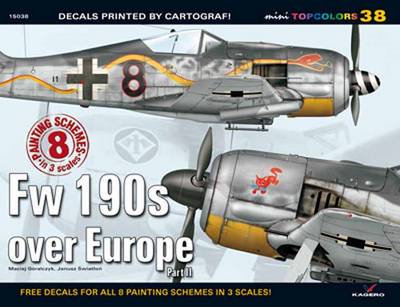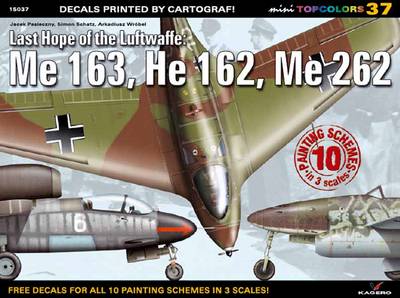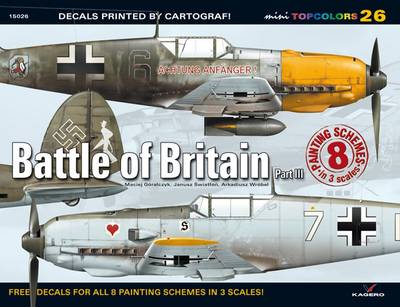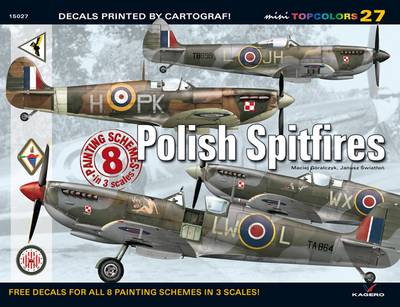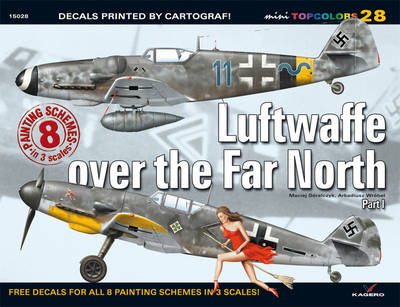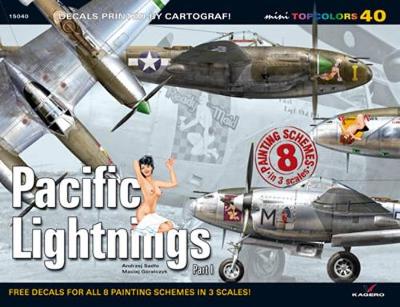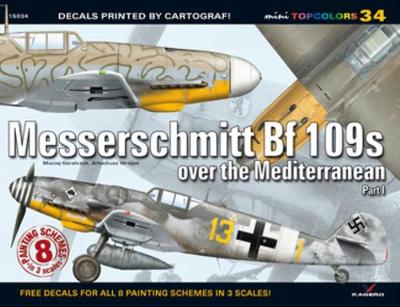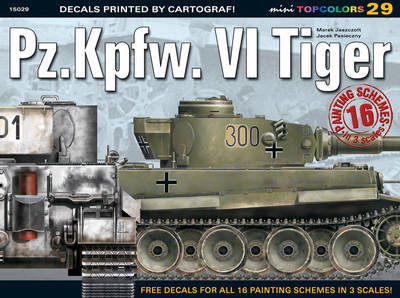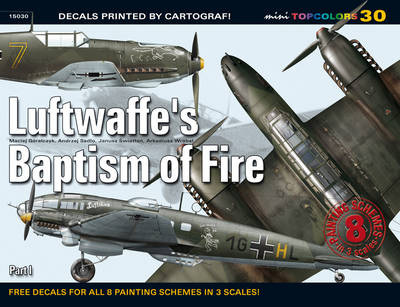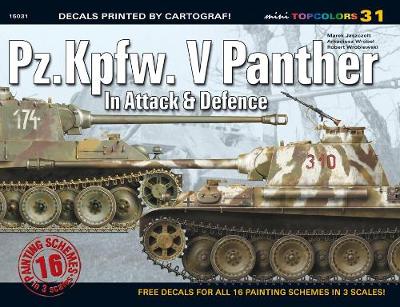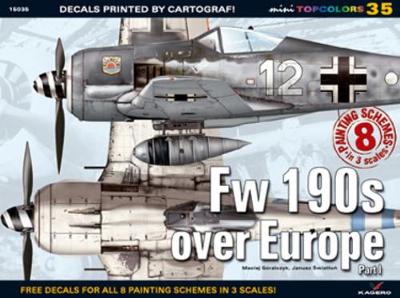Mini Topcolors
12 total works
- Focke-Wulf Fw 190 A-2; W.Nr. 0125228, 'Chevron L', flown by Ofw. Erwin Leibold of Stab I./JG 26, St. Omer-Arques, France, July 1942,
- Focke-Wulf Fw 190 A-2; W.Nr. 0125299, 'Blue 2', flown by Lt. Leopold Wenger of 10.(Jabo)/JG 2, Caen-Carpiquet, France, mid-August 1942,
- Focke-Wulf Fw 190 A-4/U7; W.Nr. 0147092, flown by Hptm. Wilhelm-Ferdinand Galland, Kommandeur of II./JG 26, Vitry-en-Artois, France, spring 1943,
- Focke-Wulf Fw 190 A-7; W.Nr. 430170, 'Yellow 5', flown by Lt. Hans Ehlers, Kapitän of 3./JG 1, Dortmund-Brakel, Germany, late December 1943,
- Focke-Wulf Fw 190 A-8/R6; probable W.Nr. 171172, 'Black 8' of 3./JGr 10, Redlin near Parchim, Germany, January 1945,
- Focke-Wulf Fw 190 A-8/R2; 'Red 10', flown by Ofw. Karl Rusack of 5./JG 300, Löbnitz, Germany, January 1945,
- Focke-Wulf Fw 190 A-8; W.Nr. 737435, 'White 20' of 9./JG 5, Herdla, Norway, 8th March 1945,
- Focke-Wulf Fw 190 A-9/R11; W.Nr. 206000, 'White 2' of III./KG(J) 27, Wels, Austria, spring 1945.
Last Hope of the Luftwaffe: Me 163, He 162, Me 262
by Arkadiusz Wrobel, Maciej Goralczyk, Jacek Pasieczny, and Simon Schatz
- Messerschmitt Me 163 B V53; W.Nr. 16310062, 'White 9', flown by Uffz. Kurt Schiebeler of 1./JG 400, Brandis, Germany, early August 1944,
- Messerschmitt Me 163 B; 'White 10', flown by Lt. Hans-Ludwig Löscher of 1./JG 400, Brandis, Germany, late February 1945,
- Messerschmitt Me 163 B V52; W.Nr. 16310061, 'Yellow 1', flown by Lt. Reinhard Opitz, Kapitän of 7./JG 400, Nordholz, Germany, April 1945,
- Heinkel He 162 A-1; W.Nr. 310003, 'Yellow 5' of 3./JG 1, Leck, Germany, May 1945,
- Heinkel He 162 A-2; W.Nr. 120067, 'White 4' of 1./JG 1, Leck, Germany, May 1945,
- Heinkel He 162 A-2; W.Nr. 120028, 'White 3' of 1./JG 1, Leck, Germany, May 1945,
- Heinkel He 162 A-2; W.Nr. 120231, 'White 6' of 1./JG 1, Leck, Germany, May 1945,
- Messerschmitt Me 262 A-2a, W.Nr. 110613, '9K+DK', flown by Ofw. Hermann Wieczorek of 2./KG 51, Rheine-Hopsten, Germany, 25th February 1945,
- Messerschmitt Me 262 A-1a, 'Yellow 2' of 3./KG(J) 54, Prague-Ruzyně, Czechoslovakia, May 1945,
- Messerschmitt Me 262 A-1a, 'White 34' of III./EJG 2, Brunnthal, Germany, May 1945.
Battle of Britain III
by Maciej Goralczyk, Janusz Swiatlon, and Arkadiusz Wrobel
Within this fantastic new addition to the miniTopcolor series you will find a big decal sheet with 1:72, 1:48 and 1:32 individual markings for 6 various Bf 109 E, 1 x Bf 110 C and 1 x Heinkel He 111 P. Each painting scheme is depicted on beautifully drawn 4-view colour profiles and thoroughly described in the 20-page guidebook with English and Polish text.
The selection includes the following aircraft:
- Bf 109 E-3; 'White Chevron', flown by Hptm. Hubertus von Bonin, Gruppenkommandeur of I./JG 54, Eindhoven, early summer 1940,
- Bf 109 E-4; W.Nr. 5274, 'White 15', flown by Ofw.Werner Machold of 1./JG 2, Beaumont-le-Roger, summer 1940,
- Bf 109 E-4/B; 'Black 6' of 5./JG 51, Mardyck, autumn 1940,
- He 111 P-2; W.Nr. 2149, coded 'G1+JL' of 3./KG 55, France, summer 1940,
- Bf 110 C-2; W.Nr. 3533, coded 'L1+LL' of 15.(Z)/LG 1, crew: pilot– Oblt. Otto Weckeiser, radio operator – Uffz. Horst Brügow; Socketts Manor, Oxted, 27 September 1940.
About the Series
This is a series of highly illustrated books on the key machines of World War II and their combat use. Perfect for modellers and filled with colour artwork profiles, each volume details the camouflage, markings, insignia, modifications and variants of the best of the war.
The selection contains the following aircraft:
- Spitfire IIa (P8387) coded PK-H of No. 315 (Deblinski) Squadron, Northolt, August 1941,
- Spitfire I (X4828) coded RF-K of No. 303 (Kosciusco) Squadron, flown by F/L Wojciech Kołaczkowski, Speke, September 1941,
- Spitfire Vb (AA853) coded WX-C of No. 302 (Poznanski) Squadron, Croydon, early July 1942,
- Spitfire F.IX (BS456) coded UZ-Żof No. 306 (Torunski) Squadron, flown by F/L Józef Żulikowski, Northolt, autumn 1942,
- Spitfire F.IX (EN179) coded SZ-J of No. 316 (Warszawski) Squadron, flown by F/L Władysław Gnyś, Northolt, spring 1943,
- Spitfire F.IX (MH353) coded WX-K of No. 302 (Poznanski) Squadron, Northolt, autumn 1943,
- Spitfire LF.IX (TA864) coded LW-L of No. 318 (Gdanski) Squadron, flown by P/O Zdzisław Uchwat, Risano near Udine, May-June 1945,
- Spitfire LF.XVI (maybe TB898) coded JH-L of No. 317 (Wilenski) Squadron, Ahlhorn, late 1945.
About the Series
This is a series of highly illustrated books on the key machines of World War II and their combat use. Perfect for modellers and filled with colour artwork profiles.
Barbarossa 1941
by Stanislaw Jablonski, Jacek Pasieczny, and Arkadiusz Wrobel
A decal sheet is included with 1:72, 1:48 and 1:35 individual and national markings for:
1 x Sd.Kfz.265
2 x 15 cm s.I.G.33 SfI auf Pz.Kpfw.I Ausf.B
1 x KW-2
2 x T-34s
2 x Pz.Kpfw.II
6 x Pz.Kpfw.III
2 x Pz.Kpfw.IV
1 x Sd.Kfz.250/3
1 x Sd.Kfz.221
About the Series
This is a series of highly illustrated books on the machines of World War II and their combat use. Perfect for modellers and filled with colour artwork profiles, each volume details the camouflage, markings, insignia, modifications and variants of the best of the war.
Luftwaffe Over the Far North Part 1
by Maciej Goralczyk and Arkadiusz Wrobel
Camouflage history has always been a fascinating topic for modelers. This series shows not only how specific vehicles or aircraft were painted, but also enables the reader to finish their model of to a very high standard by using the decals sheets.
A big decal sheet with 1:72, 1:48 and 1:32 individual markings for 8 various Luftwaffe aircraft, which served in the Far North. The decal sheet was printed by Cartograf. Each painting scheme is depicted on beautifully drawn 4-view colour profiles and thoroughly described in a guidebook with English and Polish text.
The selection contains the following aircraft:
- Bf 109 E-7; 'Yellow 7', flown by Oblt. Horst Carganico, Staffelkapitän of 1./JG 77 (JGr. z.b.V.), Petsamo, 25 September 1941,
- Bf 109 E-7, W.Nr. 6274; 'Red 19', flown by Fw. Josef Wirtz of 5./JG 5, Kirkenes-Høybuktmoen, April 1942,
- Bf 109 F-4; 'Yellow 10', flown by Fw. Hans Döbrich of 6./JG 5, Petsamo, 30 June 1942,
- Bf 109 E-7; flown by Hptm. Günther Scholz, Gruppenkommandeur of III./JG 5, Petsamo, August 1942,
- Bf 109 G-2; flown by Oblt. Günther Schwanecke of Stab II./JG 5, Salmijärvi, August-September 1943,
- Bf 109 G-14; 'Blue 11', flown by Uffz. Karl-Heinz Erler of 16./JG 5, Rygge, April 1945,
- Bf 109 G-6, W.Nr. 411960; flown by Hptm. Franz Dörr, Gruppenkommandeur of III./JG 5, Gossen, May 1945,
- Bf 110 C-4, possibly W.Nr. 3271; coded '2N+DR'
- P-38G-15-LO; s/n 43-2384, coded 'I' of 80th FS / 8th FG, Dobodura, New Guinea, autumn 1943,
- P-38E-LO; s/n 41-2221, 'Spirit of 76', coded '76', flown by 2nd Lt. John S. Mackey of 54th FS / 343rd FG, Attu, Aleutian Islands, winter of 1943/1944,
- P-38L-5-LO, s/n 44-27132, 'Ready Maid', coded 'M', flown by Capt. Phil McLain of 36th FS / 8th FG, San Jose, Mindoro, the Philippines, spring 1945,
- P-38L-5-LO, probable s/n 44-25133, 'Peck’s Bad Girl', coded 'V', flown by 2nd Lt. Charles I. Peck of 36th FS / 8th FG, San Jose, Mindoro, the Philippines, spring 1945,
- P-38L-5-LO; s/n 44-26302, 'Hazel', coded '413', flown by 1st Lt. Warren E. ‘Whip’ Whipple of 44th FS / 18th FG, the Philippines, summer 1945,
- P-38L-5-LO, s/n unknown, 'Glamour Puss II', coded 'L', flown by 1st Lt. Chester L. Schachterle of 80th FS / 8th FG, Ie Shima, Ryukyu Islands, August 1945,
- P-38L-5-LO, probable s/n 44-25161, 'Wishful Thinking', coded 'N', flown by Lt. Royce H. Hendrickson of 36th FS / 8th FG, Ie Shima, Ryukyu Islands, August 1945,
- P-38L-5-LO, s/n 44-26412, 'Shady’s Lady', coded 'P', flown by 1st Lt. William R. Pruner of 80th FS / 8th FG, Ie Shima, Ryukyu Islands, August 1945.
Messerschmitt Bf 109s Over the Mediterranean. Part 1
by Maciej Goralczyk and Arkadiusz Wrobel
- Messerschmitt Bf 109 E-7/N; probably W.Nr. 4139, 'White 11', flown by Lt. Theo Lindemann of 7./JG 26, Ain-el-Gazala, Libya, summer 1941,
- Messerschmitt Bf 109 F-4 trop; flown by Ofw. Karl-Heinz Bendert of Stab II./JG 27, Derna, Libya, December 1941,
- Messerschmitt Bf 109 F-4 trop; W.Nr. 8665, flown by Lt. Gustav Frielinghaus of Stab II./JG 3, Sicily, Italy, early 1942,
- Messerschmitt Bf 109 F-4/Z; W.Nr. 13060, 'Yellow 2', flown by Uffz. Karl-Heinz Witschke of 3./JG 77, Comiso, Italy, early July 1942,
- Messerschmitt Bf 109 G-2 trop; 'Black 7' of 2./JG 77, Tunisia, early 1943,
- Messerschmitt Bf 109 G-2/R2 trop; 'Black 19' of 2.(H)/14, La Marsa, Tunisia, March 1943,
- Messerschmitt Bf 109 G-6; 'Yellow 13', flown by Uffz. Hans Jegg of 9./JG 53, Italy, summer 1943,
- Messerschmitt Bf 109 G-6 trop; 'Black 8' of 5./JG 27, Trapani, Italy, summer 1943.
While the Tiger I was feared by many of its opponents, it was over-engineered, used expensive and labour intensive materials and production methods, and was time-consuming to produce. Only 1,347 were built between August 1942 and August 1944. The Tiger was prone to certain types of track failures and immobilizations, and limited in range by its huge fuel consumption. It was, however, generally mechanically reliable but expensive to maintain. It was also complicated to transport, and vulnerable to immobilization when mud, ice and snow froze between its overlapping and interleaved road wheels in winter weather conditions, often jamming them solid. In 1944, production was phased out in favour of the Tiger II.
A big decal sheet with 1:72, 1:48 and 1:35 individual and national markings for 16 Pz.Kpfw. VI Tiger tanks. The decal sheet was printed by Cartograf. Each painting scheme is depicted on beautifully drawn colour profile and described in the guidebook with English and Polish text.
Luftwaffe’S Baptism of Fire. Part I
by Arkadiusz Wrobel, Janusz Swiatlon, Andrzej Sadlo, and Maciej Goralczyk
Camouflage history has always been a fascinating topic for modelers. This series shows not only how specific vehicles or aircraft were painted, but also enables the reader to finish their model of to a very high standard by using the decals sheets
Features a big decal sheet with 1:72, 1:48 and 1:32 individual and national markings for German Aircraft in the Spanish campaign and the invasion of Poland. The decal sheet was printed by Cartograf. Each painting scheme is a beautifully drawn colour profile and described in the 20 page guidebook with English and Polish text.
Aircraft featured include:
- Junkers Ju 87 B-1; coded '29•8' of 5. K/88, Legion Condor, Sanjurjo airfield, Zaragoza, Spain, late 1938
- Messerschmitt Bf 109 E-1; coded '6•119', flown by Hptm. Siebelt Reents, Staffelkapitän of 1. J/88, Legion Condor, León, Spain, spring 1939,
- Messerschmitt Bf 109 E-1; 'Black 14' of 2.(J)/LG 2, Poland, mid-September 1939,
- Messerschmitt Bf 109 E-1; W.Nr. 4048, 'Yellow 7' of 3./JGr. 101, Hoya, Germany, 18 November 1939,
- Messerschmitt Bf 109 D-1; W.Nr. 630, 'Black N+7', flown by Oblt. Johannes`Macki’ Steinhoff, Staffelkapitän of 11.(N)/JG 2, Hage, Germany, April 1940,
- Messerschmitt Bf 109 E-3; flown by Oblt. Wilfried Pufahl of Stab II./JG 53, Mannheim-Sandhofen, Germany, April 1940,
- Messerschmitt Bf 110 C-2; coded 'L1+KK' of 14./LG 1, crew: Uffz. Hans Bechthold (pilot), Uffz. Wilhelm Harder (radio operator); Mannheim-Sandhofen, Germany, late spring 1940,
- Heinkel He 111 P-2; coded '1G+HL' of 3./KG 27, crew: Uffz. Otto Keiser (pilot), Hptm. Robert Sichart von Sichartshoff (observer, CO), Uffz. Gustav Bergmann (radio operator), Uffz. Paul Kleinitzke (flight engineer); Neukuhren, East Prussia, 15 September 1939 (1:32 and 1:72 decals only).
The decals also include Legion Condor markings for 1 Ju 87 and 1 Bf 109 in all 3 most popular scales and German swastikas for 1 He 111 in 1:32 and 1:72 scale.
Until 1944, it was designated as the Panzerkampfwagen V Panther and had the ordnance inventory designation of Sd.Kfz. 171. On 27 February 1944, Hitler ordered that the Roman numeral V be deleted from the designation.
The Panther tank was a compromise of various requirements. While sharing essentially the same engine as the Tiger I tank, it had better frontal armor (including the benefit of a sloping angle, increasing effective armor depth), better gun penetration, was lighter overall and thus faster, and could handle rough terrain better than the Tigers. The tradeoff was weaker side armor; the Panther proved to be deadly in open country and shooting from long range, but vulnerable to close-quarters combat. Also, the 75 mm gun fired a slightly smaller shell than the Tiger's 88 mm gun, providing less high explosive firepower against infantry.
Kagero present a new volume of the informative MiniTOPCOLORS series which shows you 16 colourful profiles of one of the most popular World War II tanks.
The high quality illustrations are based on historical photographs of the famous German tank. The Pz.Kpfw. V Panther was produced from January 1943 through to April 1945 and proved a ferocious opponent. This highly illustrated new title contains large decals sheet in three popular scales.
- Focke-Wulf Fw 190 A-3; W.Nr. 0130 541, flown by Oblt. Adolf Dickfeld, Kommandeur of II./JG 2, San Pietro, Italy, 20 November 1942,
- Focke-Wulf Fw 190 A-3/U4; W.Nr. 0135 346, 'Red 9', flown by Fw. Oskar Sahre of 5.(F)/123, St. Pol, France, early March 1943,
- Focke-Wulf Fw 190 A-5Y; flown by Maj. Hans Philipp, Kommodore of JG 1, Jever, Germany, summer 1943,
- Focke-Wulf Fw 190 A-7; flown by Hptm. Rolf Hermichen, Kommandeur of I./JG 11, Rotenburg, Germany, March 1944,
- Focke-Wulf Fw 190 A-8/R2; W.Nr. 682 181, 'Yellow 2', flown by Fw. Hubert Engst of 6./JG 300, Löbnitz, Germany, November 1944,
- Focke-Wulf Fw 190 A-9; 'Blue 7', Stab II.(Sturm)/JG 300, Löbnitz, Germany, March 1945,
- Focke-Wulf Fw 190 A-3; 'White 12', flown by Fw. Ernst Mayer of 9./JG 5, Herdla, Norway, late March 1945,
- Focke-Wulf Fw 190 A-8; W.Nr. 960 542 of Stab/JG 4, Germany, late spring 1945.
